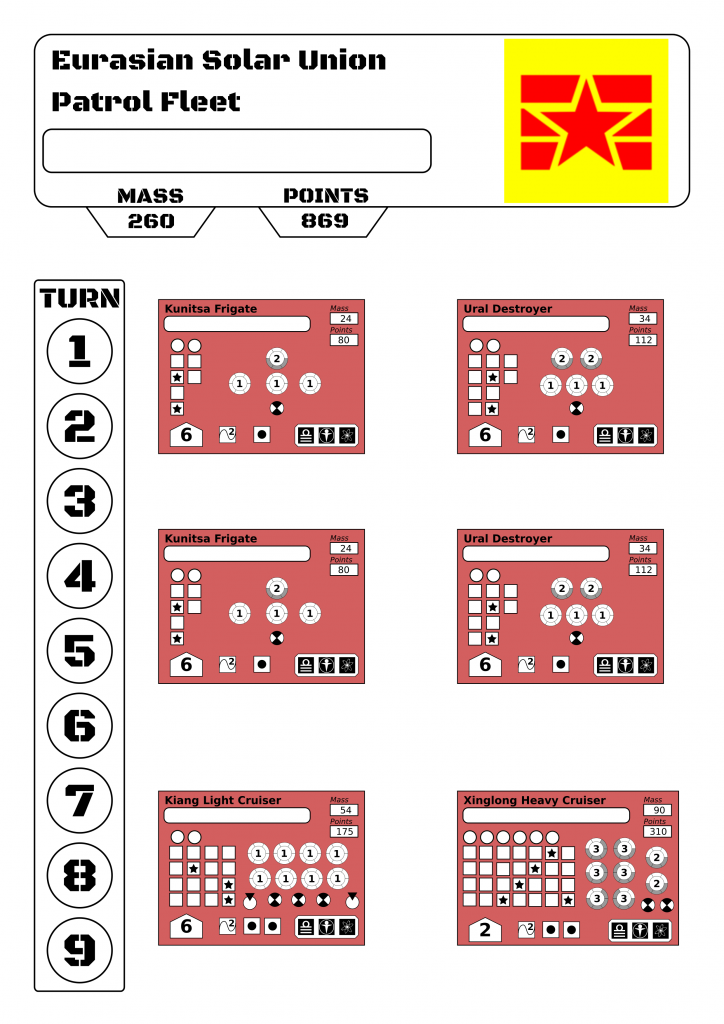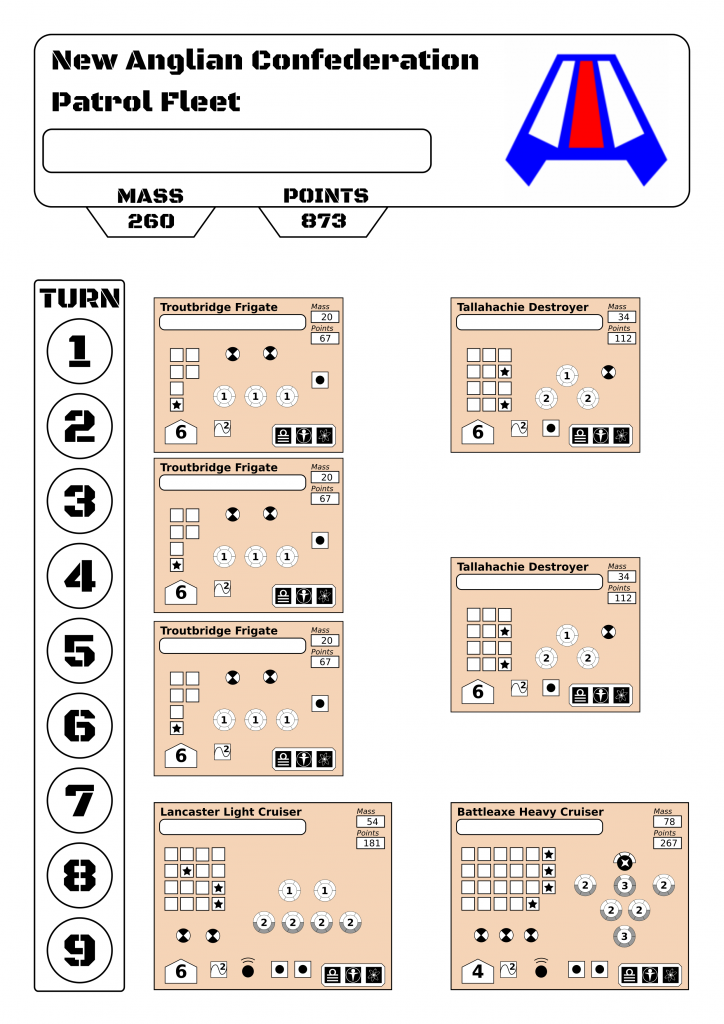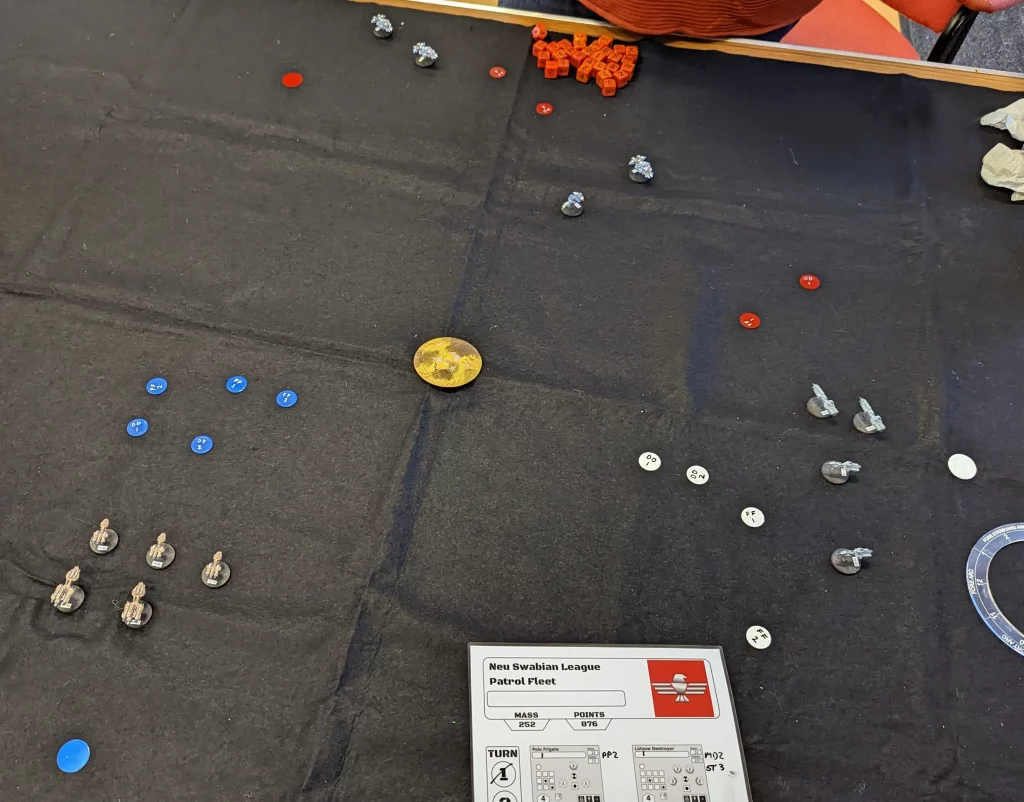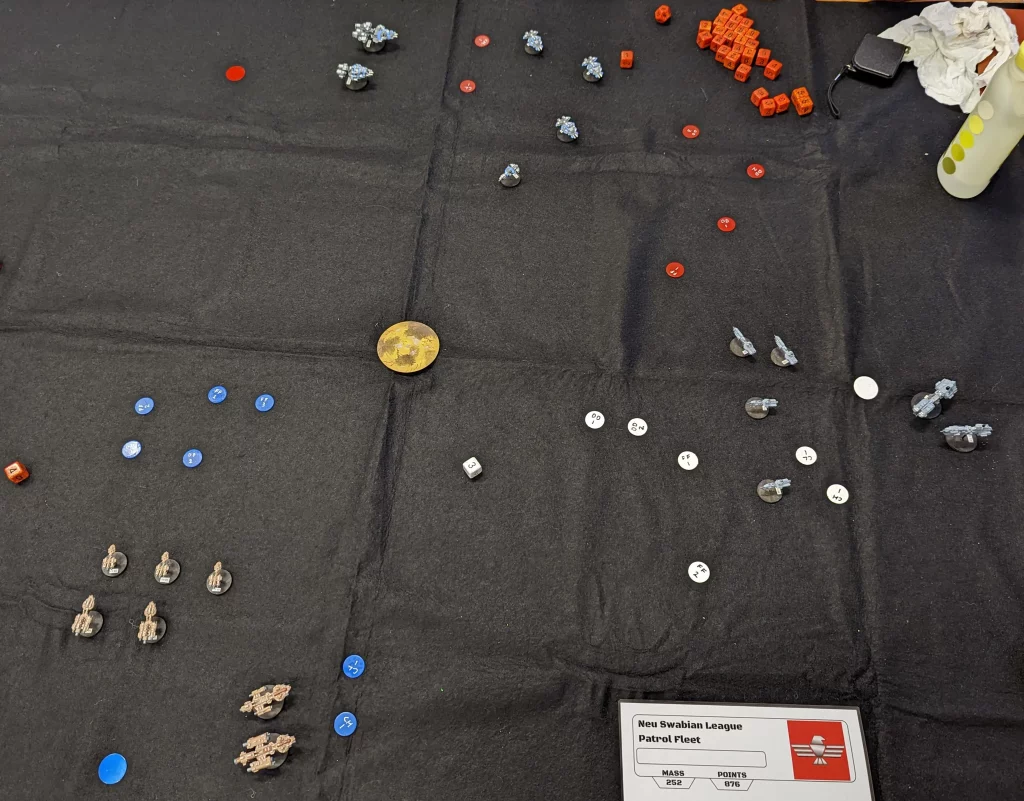Battle over Reibos IX
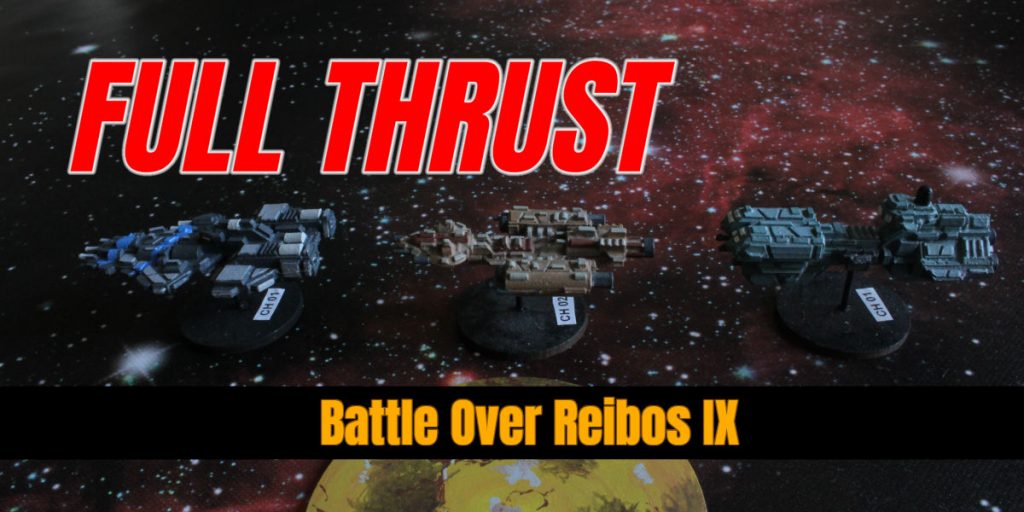
We had another opportunity for a bit of war gaming, this time Full Thrust. I had put together four fleets, with a simple scenario involving trying to capture a planet. Though there were originally two of us, I was hoping we could possibly get others interested. In the end a new club member joined us, so there were three players for a three way battle.
It’s been an awful long time (over ten years) since I’ve played Full Thrust ‘for real’ (i.e., not just a simple solo game to test things out), so I had no idea how things would play out. I decided to keep things small for the first game, though in hindsight we could have possibly gone smaller.
The base fleets had two frigates, two destroyers, a light cruiser and a heavy cruiser. Point values ranged from about 800 to 900 points, so I tweaked the lower cost fleets to bring everything up to around 870 points. All the ship designs are ones I’ve put together over the last 20 years, and they haven’t really been battle tested, so that was another concern.
The four fleets we had were:
- Neu Swabian League (252 mass, 876 points)
- Federal Stats Europa (262 mass, 862 points)
- +1 destroyer, -1 frigate
- New Anglian Confederation (260 mass, 873 points)
- +1 frigate
- Eurasian Solar Union (260 mass, 869 points)




The scenario was to last 6 turns, with a bonus for whichever fleet had sole control of the planet at the end of the sixth turn. As it was, we called it after 4 turns. The final state was:
- NAC had been almost wiped out
- NSL had taken some heavy damage, two escorts lost, but was best positioned to take the planet
- FSE had minimal damage, but was out of position

Each fleet has a slightly different design philosophy. The ESU, who didn’t take part, have long range beam lasers. The FSE are fast moving, and use salvo missiles. The NSL have heavy armour, and sturdier hull construction (three rows of hull boxes instead of four), and the NAV are pretty vanilla though were the only fleet sporting shields.
The Engagement
Since I was running the NSL, I can only speak for the intent of the NSL.
The engagement started when all three fleets came out of jump about 18″ from the planet, each 120° from each other. Initially, only the escort vessels – frigates (FF) and destroyers (DD) were available, arranging themselves within 6″ (6,000km) of their jump points. The world was a small dwarf planet in the outer system, represented by a 70mm base (2.7″, representing 2,700km in diameter). It didn’t have much effect on navigation, but is just large enough to provide some cover.
The FSE (top, red vectors) started accelerating hard towards the NSL (right, white vectors), and the NAC (left, blue vectors) began a more controlled acceleration up towards the planet and the FSE jump point. The NSL were hedging their bets, keeping their two destroyers facing the FSE, and their smaller frigates facing towards the NAC.
The NAC tactic was to move across towards the planet, whilst keeping their weapons facing towards their two enemies to see what they did. I was expecting to split my forces to engage both. From a tactics perspective, concentrating on one would have been better, but from a game perspective I wasn’t wanting to come down hard on any single opponent. Especially since I’d organised the game and had done all the ship designs, which possibly gave me an advantage. However, it didn’t work out like that.
There was a bit of long range beam weapons fire at this stage, but no losses were incurred.
At the beginning of the second turn, the cruisers came out of jump and really changed things up.
The issue that the NSL had at this point was that the NAC cruisers were heading (and facing) directly towards me. Their escorts were still leisurely moving off around the planet, expecting to engage the FSE. But the FSE was still accelerating around behind the NSL.
The vector markers make it possible to see what is happening, both during the game and in the images. The FSE and NAC have a large speed advantage over the NSL, which doesn’t have anything faster than thrust 4, and its two cruisers are thrust 2.
The NAC are mostly thrust 6, with thrust 4 cruisers. The FSE on the other hand has nothing slower than thrust 6, and the light cruiser is thrust 8. This makes them very manoeuvrable, but light in terms of firepower. The NSL are slow and ungainly, but their ships are heavily armoured and they can punch well above their size class.
Unfortunately, I probably had the most experience in using the vector movement rules, and I think because of that the NSL managed to make best use of positioning during the game despite their agility disadvantage.
At this point the NSL weren’t too concerned about the FSE – they were coming behind, but they’d have to do a heavy burn to get into close range. The NAC cruisers were more of a threat, so the NSL decided to concentrate on them. We concentrated fire on the light cruiser, though had technical issues with our pulse torpedoes (i.e., I completely forgot about them until after designating my second fire control to make a pot shot at the FSE).
Losses were being taken at this point. The NSL lost a Pola class frigate, and the NAC had lost one of its escorts as well. As we moved into turn 3, it was obvious that things were coming to a head. With the NAC fleet split into two, it was going to be an unfair fight.
Though they were making long range shots and doing some damage to the NSL, they were still mostly avoiding a direct engagement. So the NSL decided to concentrate everything on the two NAC cruisers, managing to box them in with an almost perfect positioning.
The NAC Lancaster light cruiser went down, and the NSL lost their second frigate. The NAC Battleaxe heavy cruiser took a direct hit to the bridge, briefly losing control. Fortunately their damage control parties manage to bring things online (they would have been out of action for 5 turns otherwise).
By turn four, the two heavy cruisers were bearing down on each other, with both hoping for a kill. The NSL Helgoland heavy cruiser was taking a beating (from both short range fire from the NAC, and long range hits from the FSE), but could take more punishment than the NAC Battleaxe.
The FSE stepped in though and stole the kill. They launched a salvo of missiles into the middle of the fray, and five of them locked onto the Battleaxe. It had already lost two of its three PDS, so was unable to mount a successful defence. It too vanished in a nuclear fireball.
So the Helgoland started picking off the NAC escorts at long range. The NAC escorts had already decided they wouldn’t be needed in the heavy cruiser engagement, so were heading around the planet for a direct engagement against the smaller NAC ships. In the end, only one remained.
Victory
The final result was a tied victory for the FSE and NSL, with a definite loss for the NAC.
The scoring for victory was as follows:
- +1 for destroying a CL (killing blow). If another fleet had done more damage, then +1 to them.
- +2 for destroying a CH (killing blow). If another fleet had done more damage, then +1 to them.
- -1 for each of your own FF, CL or CH destroyed.
- +3 if you are the only fleet within 3″ of the planet at end of turn 6.
Both FSE and NSL scored +2. No fleets were able to claim control of the planet, though the NSL were closest. Neither would be able to get to within 3″ of the planet by turn 6. Though the NSL were closest, they were moving away too quickly to stop in time.
Overall, it was an interesting battle. The vectored movement worked well, and the other players seemed to find it reasonably straightforward by the end. The NSL fleet is designed to not move very fast, but be tough and dangerous if they can get into a good position, which they succeeded in doing. If the NAC had kept their fleet together, or the FSE had moved in closer, then things could have gone very differently. The NSL also had some luck with the dice, both if terms of their own rolls, and the rolls of the enemy against them.
Four turns was enough for a decisive game. Six ships was a reasonable number for a small game, though four or five ships would have gone quicker. The table size we used was about right for making ranges interesting. If the FSE player had used a similar tactic with the ESU (with their class 3 beams which have a 36″ range) then they could possibly have been more effective with their long range sniping.
In any case, there are plenty of options to try out for our next game.
